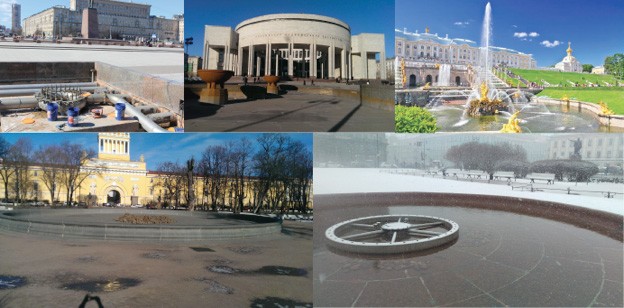By the end of March, the ongoing program to repair and renew the fountains of St. Petersburg, Russia, will be completed. PENETRON topical materials provided the integral crystalline protection for more durable concrete basins and other elements of the fountains.
The fountains of St. Petersburg are an essential part of the city’s architecture. The first fountains date back to 1705, when Peter the Great built the city on the marshy shores of the Neva River and the Gulf of Finland. Initially built in front of palaces and mansions, many fountains were later added to the city parks throughout St. Petersburg.
The St. Petersburg Waterworks Department, responsible for the maintenance of the city’s fountains, currently lists 66 fountains and four fountain complexes. The most famous fountain ensemble is the Grand Cascade at the Peterhof Grand Palace, comprised of 64 different fountains and over 200 bronze statues and bas-reliefs.
Protecting Concrete in a Harsh Environment
Water fountains generally require constant maintenance and periodic renovation and rebuilding. Especially in the cold and wet Russian climate, concrete structures can deteriorate rapidly, resulting in massive cracks and concrete scaling.
Last year, Penetron St. Petersburg was asked by the St. Petersburg Waterworks Department to recommend a technical solution. They were also hired to repair the concrete basins of a number of well-known fountains, including the Kazan Cathedral Fountain, the Admiralty College Fountain, and the more contemporary fountains in front of the National Library, Moscow Square, and Novo-Manezhnyy Skver. The experts at Penetron St. Petersburg recommended a repair program using the PENETRON System of crystalline topical products, including a combination of PENETRON topical material and PENECRETE MORTAR for cracks and seams.
Blocking Moisture Penetration in Concrete
Mixed with water and applied with a brush, trowel or spray gun, PENETRON topical material is applied as a slurry to concrete structures. Once applied, the integral crystalline technology is absorbed into the underlying concrete and successfully blocks any moisture penetration into the concrete structure, even when exposed to harsh environments like the St. Petersburg climate. It also provides a permanent self-healing capability to seal cracks that may appear later. PENECRETE MORTAR is ideal for filling cracks, seams, and joints, and to fill routed-out cracks and honeycombed (spalled) and damaged areas.
The Penetron team first prepared all the damaged areas, routing out the cracks, cleaning the seams, and then filling in the prepared areas with PENECRETE MORTAR. In a final stage, PENETRON was applied as a slurry to the concrete surfaces of the fountains.
“Providing the technology and know-how to preserve the fountains of St. Petersburg for future generations is the perfect showcase for PENETRON crystalline technology,” says Robert Revera, President and CEO of The Penetron Group. “Penetron is proud to be part of this effort to preserve the cultural heritage of St. Petersburg.”

Protected by PENETRON: Water fountains require constant maintenance, especially in the cold Russian climate, to avoid rapid deterioration. PENETRON crystalline technology provides crucial durability.
